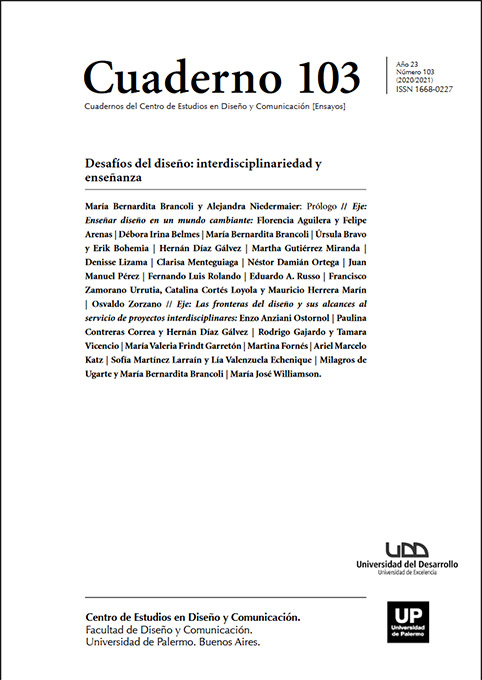Diseño, antropología y complejidad social: cocreación en el territorio, el caso Saber Hacer
Resumen
Existe una creciente inquietud en el diseño, por integrar diferentes formas de aproximación a las experiencias de intervención territorial. El uso de metodologías provenientes desde las Ciencias Sociales ha acaparado la atención, sobre todo los beneficios de incorporar el método etnográfico al trabajo del diseño en general. En el presente artículo ahondaremos en esta relación entre Diseño y Antropología, además de exponer la propia experiencia de los autores en esta mixtura de disciplinas. Por lo tanto, este trabajo no pretende ser un estudio de caso, sino el relato de una experiencia que nos lleve por la relación de los métodos de innovación del diseño y la antropología; así como también, hacia las bases epistemológicas y metodológicas del trabajo de observación etnográfica. Lo anterior, relacionado a la experiencia de la Fundación Saber Hacer en el proyecto, desarrollado en la comuna de Peñalolén de Santiago de Chile, llamado Diseño+Oficios.
Este análisis de experiencia es constituyente de un enfoque híbrido de diseño y antropología expuesto por los autores, donde los métodos de análisis territorial y cultural se combinan con los métodos proyectivos del diseño para la innovación, resultando en estrategias de innovación abierta para el trabajo con comunidades y territorios, aportando con nuevas formas de economía social, basadas en experiencias de co-creación y desarrollo de comunidades en entornos intensivos de colaboración.
Citas
Abarca, F. (2012). “Nuevas visiones para tiempos nuevos: Hacia aprendizajes holistas como derecho de la humanidad”, en Revista Latinoamericana de Derechos Humanos, Vol. 23(Nº 2), 61-85.
Abarca, F. (2016). “La metodología participativa para la intervención social: Reflexiones desde la práctica”, en Revista Ensayos Pedagógicos, Vol. XI(Nº 1), 87-109.
Augé, M y Colleyn, J.P. (2006). ¿Qué es la Antropología?, Madrid: Paidos.
Akhilesh, K.B. (2017). Co-creation and learning: Concepts and cases, Bangalore, Karnataka: SpringerBriefs in Business.
Bourdieu, P. (1997). Razones prácticas: sobre la teoría de la acción, Barcelona: Editorial Anagrama.
Brown, T. (2008). “Design Thinking”, en Harvard Business Review, June 2008. Harvard Business School Publishing Corporation.
Da Ros, G. (2007). “Economía solidaria: aspectos teóricos y experiencias”, en uniRcoop. Vol. 5, N.° 1, disponible en: http://base.socioeco.org/docs/economia-solidaria-aspectosteoricos.pdf
Cortina, A. (2007). Ética de la razón cordial. Educar en la ciudadanía en el siglo XXI, España: Ediciones Nobel.
Fundación Saber Hacer (2018). Diseño + Oficios 2016-2017. Memoria proyecto FIC-R 2015 Gobierno Regional Metropolitano de Santiago, Santiago de Chile: Editorial Fundación Saber Hacer.
Geertz, C. (2005). La interpretación de las culturas, Barcelona: Gedisa.
Guber, R. (2011). La etnografía. Método, campo y reflexividad, Buenos Aires: Siglo XXI.
Gunn, W., Otto, T. & Smith, R.C. (2013). Design Anthropology: Theory and Practice, London: Bloomsbury.
Manzini, E. (2015). Cuando todos diseñan. Una Introducción al diseño para la innovación social, Madrid: Experimenta Theoria y Massachusetts Institute of Technology.
Montero, C. (2000). La formación de capital humano en empleos atípicos: el caso del trabajo a domicilio, Santiago de Chile: CEPAL y GTZ.
Najmanovich, D. (2008). Mirar con nuevos ojos: nuevos paradigmas de ciencia y el pensamiento complejo, Buenos Aires: Editorial Biblos.
Nussbaum, B. (2004). “The power of design”, en BusinessWeek 17 de mayo 2004. The McGraw-Hill Companies Inc.
Restrepo, E. (2018). Etnografía. Alcances, técnicas y éticas, Lima: Fondo Editorial de la Universidad Nacional Mayor de San Marcos.
Sanders, E. y Stappers, P. (2014). Convivial Toolbox: Generative research for the front end of design, Amsterdam: The Netherlands: BIS Publishers.
Sanders, E. y Stappers, P. (2008). Co-creation and the new landscapes of design, UK: CoDesign, Taylor & Francis.
Tokman, V. (2001). De la informalidad a la modernidad, Santiago de Chile: Organización Internacional del Trabajo.
Verganti, R. (2009). Design-driven Innovation, Boston MA: Harvard Business Press.
Los autores/as que publiquen en esta revista ceden los derechos de autor y de publicación a "Cuadernos del Centro de Estudios de Diseño y Comunicación", Aceptando el registro de su trabajo bajo una licencia de atribución de Creative Commons, que permite a terceros utilizar lo publicado siempre que de el crédito pertinente a los autores y a esta revista.


